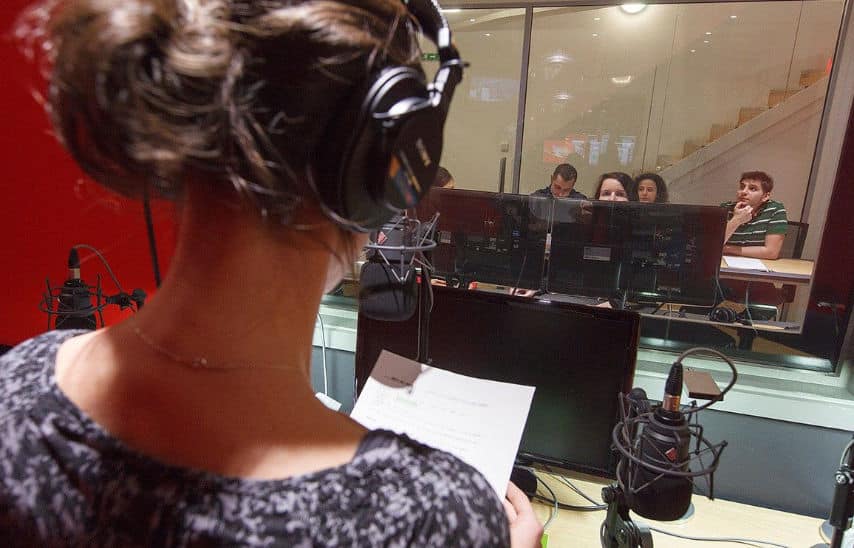In the dynamic realm of corporate communications, the power of the spoken word cannot be underestimated. Voice overs have the unique ability to bring your brand’s message to life, connecting with audiences on a level that text alone cannot reach. From the subtle inflections that convey trust to the emphatic tones that drive a call to action, a voice over can make all the difference in the perception and professionalism of your corporate content.
Table of Contents
ToggleThe Fundamentals of Corporate Voice Over Pricing
The pricing of corporate voice overs is an art in itself, nuanced by a spectrum of factors that set it apart from other voice work genres. Unlike voice overs for entertainment, which may often ride on the allure of character and storytelling, corporate voice overs are the linchpins of professional presentation and brand identity. They’re the cornerstone of how a business communicates with its stakeholders, be it employees, potential clients, or investors, hence the need for a pricing model that reflects not only the talent and time involved but also the strategic importance of the end product.
When considering the fundamentals of corporate voice over rates, we delve into a realm where clarity, precision, and a tone that echoes the ethos of the company are paramount. The voice over artist must not only be a master of diction and tone but also embody the corporate brand’s values and mission. Therefore, the corporate voice over rate encompasses more than just the recording time; it’s an investment in a voice that will carry the brand’s message across various platforms and mediums.
Moreover, corporate projects often demand a quick turnaround and might require the voice talent to be available for updates or changes as the project evolves. This responsiveness and flexibility are intrinsic to the corporate voice over rate, distinguishing it from other voice work where schedules can be more flexible and changes less frequent.
As such, corporate voice over pricing is tailored to meet these specific demands, ensuring that businesses can budget effectively for a voice that will not only convey their message but also enhance their corporate image and brand integrity. This section of the guide aims to unpack these pricing structures and provide a transparent view into what businesses can expect when they invest in a corporate voice over service.
Standard Rate Structures for Corporate Voice Overs
When venturing into the world of corporate voice overs, you’ll encounter a variety of rate structures that cater to different project needs. These structures are devised to offer flexibility and to accommodate the specificities of each assignment, whether it’s a brief company announcement or an extensive training module. Let’s explore the standard per-minute, per-hour, and per-word rates to give you a clearer picture of what to expect.
– Corporate Voice Over “Per Minute” Rate
The per-minute rate is commonly adopted for projects where the script is concise and the recording time is predictably short. It’s a straightforward pricing model that charges based on the length of the final audio product, rather than the time spent in the studio. This rate is particularly beneficial for tight, script-driven content such as short corporate promos, product teasers, or quick informational videos where a company wants to deliver a message succinctly and effectively. In this model, clients are able to calculate the cost upfront based on the script length, which aids in straightforward budgeting and financial planning.
– Corporate Voice Over “Per Hour” Rate
Discussing the per-hour rate requires an understanding of two perspectives: the final product duration and the actual studio time. In the corporate voice over sphere, the per-hour rate often refers to the studio time, including the recording, editing, and mastering of the audio. This rate is advantageous for projects that are complex, require multiple takes, or involve intricate post-production work. It’s suited for lengthier content such as e-learning courses, in-depth product demonstrations, or corporate training modules, where the recording session might extend over several hours.
– Corporate Voice Over “Per Word” Rate
The per-word rate structure is particularly transparent and is often utilised for projects where the script may undergo changes or when the exact length of the final product is not known in advance. It provides a clear cost per word, which can be especially useful for corporate projects like training videos or product manuals that are updated regularly with new information or terminology. With this model, companies can manage their budget according to the script’s length and complexity, which can fluctuate during the project’s life cycle.
Each of these rate structures serves different project requirements and offers a level of financial predictability. It is imperative for businesses to consider the nature of their project, the expected turnaround time, and the potential for script changes when choosing the most appropriate rate structure for their corporate voice over needs.
Key Influences on Corporate Voice Over Rates
In the specialised sphere of corporate communications, determining the rates for voice over services goes beyond basic calculations. It is a multi-faceted decision that is influenced by a variety of factors, each playing a significant role in shaping the final quotation. For businesses seeking to employ these services, an understanding of these influences is critical to anticipating costs and ensuring that the voice over delivers the intended value.
The corporate sector demands a level of sophistication and precision that is reflected in the voice over rate. From the experience of the voice artist to the intended use of the recording, the variables are numerous. The language, accent, and tone must align with the brand’s image and the message it aims to convey. Furthermore, the technical requirements, such as audio quality and the need for synchronisation with video or on-screen graphics, can also adjust the rates.
Moreover, the scope of usage plays a pivotal role; a voice over intended for a small internal presentation may not command the same rate as one that will be the centrepiece of an international marketing campaign. The length of usage, whether it’s a one-off event or an ongoing requirement, will also factor into the cost. Additional elements like turnaround times, revisions, and the necessity for exclusivity can all influence the corporate voice over rate.
In this section, we delve into these key factors in detail, providing clarity on how they converge to form the rates that businesses can expect to encounter in the corporate voice over market. This analysis aims to equip you with the knowledge to navigate rate negotiations, understand the value behind the figures, and make informed decisions that align with your corporate audio strategies.
Script Length and Complexity
When it comes to corporate voice overs, two of the most significant determinants of pricing are the length and the complexity of the script. These elements are critical because they directly impact the amount of time and the level of skill required to deliver the final product to the client’s specifications.
- Script Length
The length of the script is typically measured in words or minutes and is a primary factor in calculating the corporate voice over rate. A longer script will naturally require more studio time for recording, which also translates to a longer period for editing and post-production. The rate may be determined on a per-word, per-minute, or per-hour basis, depending on the service provider and the preferences of the client. For instance, a brief, succinct script intended for a quick corporate announcement will cost less than a comprehensive training module designed to educate employees on complex procedures.
- Script Complexity
However, length is not the only factor; the complexity of the script also plays a crucial role. A script laden with technical jargon, industry-specific terminology, or intricate narrative requirements demands a voice over artist with the expertise to deliver the material convincingly and accurately. This level of proficiency can influence the rate, as artists with such specialised skills are often in higher demand and may command a premium.
Furthermore, complexity can extend to the script’s structure. If a script requires a conversational tone, multiple characters, or varying emotions, it becomes a more complex project. This complexity requires more preparation and versatility from the voice artist, not to mention additional direction and production time, all of which can increase the rate.
Production Timelines
The urgency of production timelines is another critical factor that can considerably affect the corporate voice over rate structure. Time is a premium commodity in business, and the faster a voice over can be turned around, the more valuable it becomes. When a project is required to be completed with expedited delivery, it places the voice artist and production team under a tighter schedule, which often necessitates a higher rate.
- Impact of Urgent Deadlines
Urgent deadlines may arise from a need to respond to market changes, to update corporate training materials swiftly, or to launch a product at short notice. In such cases, the voice over artist may need to prioritise one project over others, potentially working outside of normal business hours to meet the client’s timeline. This level of service flexibility can lead to what is known as a ‘rush fee’ or ‘expedite fee’, which is an additional charge on top of the standard corporate voice over rate.
The expedite fee compensates for the quick turnaround and covers any additional costs that may be incurred to deliver the project on time. This might include overtime for the voice artist and production staff, as well as the use of faster, sometimes more expensive, methods for delivering the finished product.
- Planning Ahead
It’s important for businesses to plan their voice over needs well in advance to avoid these additional costs. However, when urgent deadlines are unavoidable, understanding that these will impact the rate structure is crucial for budgeting purposes. The cost of a quick turnaround should be weighed against the potential benefits of meeting the market demand or internal corporate deadlines.
In short, production timelines are a significant factor in the corporate voice over rate equation. The more pressing the deadline, the higher the investment might be. By acknowledging this, businesses can make informed decisions and plan accordingly to ensure that their corporate voice over needs are met without compromising on quality or timing.
Usage Rights and Exclusivity
In the corporate voice over industry, the intended use and distribution of the recorded material are significant factors that can influence the overall rates. When a voice talent records a piece, the client is purchasing the ability to use that recording, which is where usage rights and exclusivity come into play.
- The Significance of Usage Rights
Usage rights pertain to how the voice over will be used—whether for internal training, external advertising, or as part of a product that will be sold. The broader and more public the use, the higher the value of the voice over. For instance, a recording for a regional advertising campaign will typically cost less than a national or global campaign due to the difference in exposure and potential impact.
Additionally, the duration of use is a key component. A corporate voice over intended for a limited-time marketing campaign might incur a lower rate compared to one that will be used indefinitely. Voice over providers may offer different packages based on usage duration, such as short-term, annual, or full buyout rates, giving clients the flexibility to choose according to their needs.
- The Impact of Exclusivity
Exclusivity is another aspect that can affect corporate voice over rates. If a client requires the voice talent to be exclusive to their brand—meaning the artist would be restricted from providing services to competing businesses or industries—this limitation on the artist’s ability to work with others would be reflected in the cost. Exclusivity ensures that the voice associated with one corporate identity isn’t heard representing another, maintaining a unique brand voice. This comes at a premium due to the potential work the voice artist is foregoing.
In essence, understanding how usage rights and exclusivity clauses impact the corporate voice over rate is crucial for businesses. It allows for strategic planning and ensures that the voice over work aligns with the company’s marketing and branding efforts, all while staying within the bounds of their budgetary constraints. As such, these factors must be clearly communicated and negotiated with the voice over provider before commencing the project to avoid any misunderstandings and to ensure that the corporate voice over serves its intended purpose effectively and exclusively, if required.
Corporate Narration vs. Corporate Commercials
Within the corporate domain, voice over work can broadly be categorised into two primary types: corporate narration and corporate commercials. Each serves a distinct purpose and, as a result, commands different rate structures.
Corporate Narration Rates
Corporate narration typically encompasses a variety of projects such as training videos, company presentations, product demonstrations, and e-learning modules. The rates for these narrations are often calculated based on the length of the recording or the number of words in the script. Narration projects tend to have a more extended shelf life and are used within the company or in non-broadcast environments.
The rates for corporate narration may be lower than for commercials, as the usage is generally limited to the corporate environment and does not require the broadcast rights that commercials do. Additionally, corporate narrations usually do not demand the same level of vocal intensity or variety as commercials. Instead, they require a clear, informative tone that conveys information effectively and engages the listener without the sales-driven approach of commercials.
Corporate Commercial Rates
Corporate commercials, on the other hand, are produced with the intention of broadcasting—whether on television, radio, or online platforms. These voice overs are designed to sell or promote a product, service, or the corporate brand itself and are often characterised by a persuasive, dynamic delivery. The rates for commercials are typically higher due to the additional considerations of broadcast reach, licensing for different media, and the potential for regional, national, or international distribution.
Furthermore, commercial voice overs often require exclusivity, especially if the voice artist becomes the ‘voice’ of the brand, and this exclusivity can significantly impact the rate. Commercials may also have a shorter run time than narrations, leading to more frequent updates and re-recordings, which is another factor that influences the pricing.
In summary, when it comes to corporate voice over rates, the distinction between narration and commercial work is significant. Narration rates are primarily influenced by the content’s length and the scope of internal use, while commercial rates are driven by the complexities of broadcasting rights, distribution scale, and exclusivity. Understanding these differences is key for businesses to budget accurately for their voice over needs and to ensure that the chosen voice over artist is compensated fairly for their work, according to the project’s demands.
Customising Your Corporate Voice Over Package
In the nuanced field of corporate voice overs, one size does not fit all. Customisation is key to ensuring that the voice over not only meets the specific needs of your corporate project but also aligns with your brand’s identity. This tailored approach, however, introduces variability into the pricing, as the cost will reflect the bespoke nature of the service provided.
When we talk about customising a corporate voice over package, we are considering several layers of personalisation. From selecting the right voice talent to match your brand’s tone, to the specifics of delivery style, language, accent, and technical requirements—each of these aspects can be customised and, consequently, can influence the corporate voice over rate.
The benefits of a custom voice over package are manifold. It allows for a voice that is congruent with your brand’s image, delivers your message in the most impactful way, and can be adapted to fit a variety of mediums, whether it’s for an online advertisement, an in-house training video, or a customer-facing product guide. Furthermore, customisation can extend to the terms of service, including the number of revisions allowed, the turnaround time, and the provision for ongoing updates or series work.
However, the more tailored the requirements, the more time and resources are necessary to fulfil them, leading to a higher rate compared to standard packages. For example, sourcing a voice over artist with a specific linguistic capability or requiring a quick turnaround on a complex script will likely increase the cost.
Understanding the relationship between customisation and cost is essential for businesses planning to invest in corporate voice overs. It enables effective budgeting and ensures that the final product is not just a generic voice but a distinctive sound that can make your corporate content stand out. As we delve further into this section, we will explore the various elements that can be customised in a voice over package and how each can potentially adjust the overall rate.
Tailored Voice Matching
The process of matching the right voice to your corporate identity is a critical one, as the selected voice becomes an audible representation of your brand. It’s not merely about finding a voice that sounds pleasant—it’s about discovering the voice that resonates with your company’s values, target audience, and the message you wish to convey.
The Process of Voice Matching
Tailored voice matching involves a careful audition process where voice over artists are evaluated not just on the quality of their voice, but on their ability to connect with the material and deliver it in a way that aligns with the brand’s personality. It may include reviewing various voice samples, or holding casting sessions to find the right match. This process is often time-consuming and involves the expertise of casting directors and sound engineers, in addition to the voice over artists themselves.
Importance in Corporate Identity
The importance of this process in shaping corporate identity cannot be overstated. A voice that perfectly encapsulates a brand’s ethos can elevate corporate materials, whether in marketing, training, or customer engagement, creating a more profound connection with the audience. The consistency of using the same voice across different platforms also aids in building brand recognition, which is invaluable in today’s crowded marketplace.
Influence on the Rate
Given the bespoke nature of this service, tailored voice matching can influence the corporate voice over rate. The search for the perfect voice talent can require additional resources, and once found, the unique attributes of the voice artist may come with a higher price tag, especially if they have a distinctive tone, a specific skill set, or bilingual capabilities. Furthermore, if exclusivity is desired, where the voice artist is asked not to lend their voice to competing brands, this will also be factored into the rate.
In short, tailored voice matching is a service that requires meticulous selection and a strategic approach. The resulting corporate voice over rate will reflect the value that this voice adds to your corporate identity and the impact it is expected to have on your audience. Businesses must weigh the benefits of having a distinctive, brand-aligned voice against the associated costs and consider this investment as part of their broader branding strategy.
Multilingual and International Rates
The global nature of today’s corporate environment often necessitates communication across borders and in multiple languages. Corporate voice overs that cater to international markets or are required to be multilingual carry their own set of considerations, which can have significant implications for rate structures.
Considerations for Multilingual Voice Overs
When a corporate voice over project requires multiple languages, it involves sourcing voice talent with specific linguistic capabilities. The selection process for multilingual voice artists is more complex, as it demands not only fluency in the language but also an understanding of cultural nuances and regional accents that resonate with the target audience. This talent pool can be smaller and more specialised, which may lead to higher rates due to the demand for such specific skill sets. Moreover, the recording process can be lengthier and more technical. It may involve additional directors or linguistic experts to ensure accuracy, and this level of expertise and additional time spent in the studio will be reflected in the cost.
Rates for International Voice Overs
For voice overs intended for international distribution, there are further factors to consider. Different markets may have varying industry standards and union requirements that can influence the rate. Additionally, the usage rights for a global audience are broader and will typically increase the rate compared to a domestic-only release.
The scale of distribution also matters. A voice over that is to be broadcast internationally might require additional legal considerations and rights management, which can add complexity and cost to the project. The necessity for localisation, which includes adapting the content to suit local markets, can further affect the rate, requiring additional scriptwriters and voice artists to ensure that the voice over is culturally and contextually appropriate for each region.
In summary, multilingual and international corporate voice overs are a sophisticated service reflecting the intricacies of global communication. The rates for these services are influenced by the demands of sourcing specialised talent, the complexity of the recording process, and the legal and cultural considerations of international distribution. Businesses venturing into multilingual or international voice over work must account for these factors in their budgeting to ensure successful communication across their global audience.
The Comprehensive Service of Multilingual and International Communication
GoLocalise understands that multilingual and international corporate communication is not just about voice over—it’s a comprehensive service that includes professional translation and subtitling to meet the highest standards of global business outreach. The rates reflect the dedication to delivering a seamless experience to your international audience through a symphony of expertly crafted audio and visual elements.
In summary, as businesses pursue multilingual or international voice over work, they must consider the full scope of services required, including translation and subtitling. These elements are crucial for successful cross-cultural communication and are reflected in the cost. With GoLocalise, you can trust that your corporate content will be expertly handled, ensuring clear and effective communication to your global audience.
Bundling Services: Bulk Discounts and Retainer Agreements
In the corporate voice over market, companies often require a series of voice over services rather than a one-off project. This ongoing need can be cost-effectively managed through bulk discounts or retainer agreements, which offer a mutually beneficial arrangement for both the service provider and the client.
Bulk Discounts
Bulk discounts are typically offered when a company commits to a large volume of work upfront. This could mean contracting multiple projects at once, such as a series of advertisements, training modules, or corporate announcements. By ordering in bulk, the client can secure a lower rate per unit of work, as it allows the voice over provider to plan and allocate resources more efficiently. It’s a straightforward economy of scale; the more work you commit to, the less expensive the individual pieces become.
Bulk discounts not only reduce the cost per project but also ensure consistency in quality and style, as the same voice talent can be retained across all pieces. This consistency is valuable in maintaining a cohesive corporate identity and can streamline the production process, saving time and additional costs associated with sourcing and auditioning new voices for each project.
Retainer Agreements
Retainer agreements, on the other hand, involve a client paying a recurring fee to retain voice over services over a period of time. This arrangement guarantees the client a certain amount of voice over work each month or quarter, for instance, and secures the availability of the voice talent. The benefit of a retainer is the preferential rate it offers, as it provides the voice over artist with predictable income and work schedule.
Retainers are particularly advantageous for companies with regular, ongoing voice over needs. They eliminate the need to renegotiate rates for each project and can provide priority service, often with quicker turnaround times. Additionally, retainers can be customised to include a set number of revisions or updates, ensuring that the voice over content remains current and flexible to the company’s changing needs.
In essence, both bulk discounts and retainer agreements are strategic options for businesses looking to manage their corporate voice over expenses more effectively. These arrangements can lead to substantial savings, especially for companies with frequent and predictable voice over requirements, and allow for long-term planning and budgeting for their corporate communication strategies.
Final Thoughts
Understanding the intricacies of corporate voice over rates is more than a mere financial exercise; it’s a strategic step towards ensuring that your corporate communications resonate with your intended audience while aligning with your budgetary framework. From the length and complexity of your script to the urgency of production timelines, from the necessity of usage rights to the potential for multilingual reach – each factor intricately weaves into the tapestry of voice over pricing. It is this nuanced understanding that enables effective budgeting and planning, ensuring that your investment in voice over services translates into tangible value for your business.
Whether you’re looking to launch a comprehensive training program, unveil a new product with a compelling narrative, or establish a consistent brand voice across various platforms, having a clear roadmap of the costs involved is indispensable. It’s not just about finding a voice; it’s about investing in a partnership that will elevate your corporate presence and help you communicate with confidence and clarity.
Are you ready to give your company’s voice the clarity and impact it deserves? Reach out to GoLocalise for a detailed and personalised quote that meets your specific corporate voice over needs. Our team of experts is dedicated to providing you with a tailored solution that not only fits your project’s requirements but also supports your budgetary goals. Don’t let the complexity of voice over rates be a barrier – let us guide you through the process with ease and precision. Contact GoLocalise today, and take the first step towards transforming your corporate communications.
FAQs
How are corporate voice over rates determined?
Corporate voice over rates are primarily determined by the length of the recording, the complexity of the script, the experience of the voice artist, and the intended usage and distribution of the final product. Factors like exclusivity and the need for multilingual talent can also influence the rate.
What is the difference between per-minute and per-hour rates?
Per-minute rates are typically used for the final length of the voice over product, which can be beneficial for shorter scripts. Per-hour rates usually apply to the time spent in the studio recording and editing the audio and are more cost-effective for longer or more complex projects.
Can I get a discount for bulk or multiple corporate voice over projects?
Yes, discounts for bulk or multiple projects are common in the voice over industry, as they allow for efficient resource management and scheduling.
Are rush fees applied to urgent voice over projects?
Urgent projects that require a quick turnaround may incur rush fees. These fees compensate for the additional resources needed to prioritise and complete the project to meet your tight deadlines.
Does requiring a voice over artist for exclusivity affect the rate?
If a voice over project requires the artist to refrain from working with competing brands or for similar projects, this exclusivity can affect the rate, reflecting the limitation on the artist’s ability to take on other work.
How do multilingual voice over requirements impact the rate?
Multilingual voice overs often involve specialised talent capable of delivering accurate and culturally resonant performances in additional languages, which can influence the rate due to the expertise and additional casting required.
Are there additional charges for international usage of a corporate voice over?
Voice overs intended for international distribution may include additional costs for broader usage rights and potential localisation needs, ensuring the content is appropriate for each target market.
What is a retainer agreement, and how can it benefit my company?
A retainer agreement is a fixed-term contract where you secure voice over services over a set period, often at a preferential rate. This can be beneficial for companies with regular, ongoing voice over requirements, offering cost savings and guaranteed availability of talent.
How flexible are voice over rates?
Voice over rates can have some flexibility depending on the project’s specifics and the relationship with the provider. At GoLocalise, we strive to work with our clients to meet their budgetary constraints while delivering high-quality voice overs.
How can I get an accurate quote for my corporate voice over project?
For an accurate quote, you should provide detailed information about your project, including the script length, complexity, language requirements, and intended use. Contact us with these details, and we can provide a tailored quote that fits your specific needs.






















